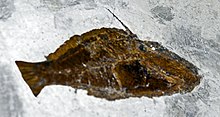Frigocanthus is a genus of extinct tetraodontiform marine fishes.
| Frigocanthus Temporal range:
| |
|---|---|

| |
| Fossil of Frigocanthus margaritatus | |

| |
| Fossil of Frigocanthus stroppanobili | |
| Scientific classification | |
| Domain: | Eukaryota |
| Kingdom: | Animalia |
| Phylum: | Chordata |
| Class: | Actinopterygii |
| Order: | Tetraodontiformes |
| Family: | Monacanthidae |
| Genus: | †Frigocanthus Sorbini & Tyler, 2004 |
Species
edit- Frigocanthus margaritatus
- Frigocanthus stroppanobili
Fossil record
editFossils of Frigocanthus are found in the Pliocene and Pleistocene of Italy and in the Pliocene of Greece.[1]
Description
editThe filefishes of the genus Frigocanthus have 21 vertebrae and show a remarkable enlargement of scales. Furthermore, they have a strong first dorsal spine with large, prominent barbs. The species Frigocanthus margaritatus can reach a length of about 310 millimetres (12 in).[1]
Bibliography
edit- Sorbini, C. & Tyler, J.C. (2004) Review of the fossil file fishes of the family Monacanthidae (Tetraodontiformes), Pliocene and Pleistocene of Europe, with a new genus, Frigocanthus, and two new species related to the Recent Aluterus. Bollettino del Museo Civico di Storia Naturale di Verona, 28, 41–76. Geologia Paleontologia Preistoria
References
edit- ^ a b YUSUKE MIYAJIMA, FUMIO OHE, HAKUICHI KOIKE & HIROSHIGE MATSUOKA First fossil occurrence of a filefish (Tetraodontiformes; Monacanthidae) in Asia, from the Middle Miocene in Nagano Prefecture, central Japan Zootaxa 3786 (3): 382–400